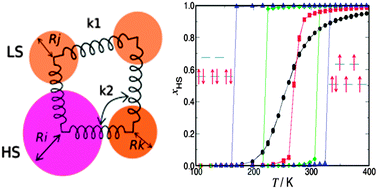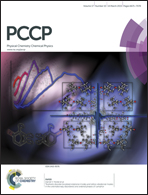Monte-Carlo simulations of spin-crossover phenomena based on a vibronic Ising-like model with realistic parameters†
Abstract
Materials with spin-crossover (SCO) properties hold great potential in information storage and therefore have received a lot of concerns in recent decades. The hysteresis phenomena accompanying SCO are attributed to the intermolecular cooperativity whose underlying mechanism may have a vibronic origin. In this work, a new vibronic Ising-like model in which the elastic coupling between SCO centers is included by considering harmonic stretching and bending (SAB) interactions is proposed and solved by Monte Carlo (MC) simulations. The key parameters in the new model, k1 and k2, corresponding to the elastic constant of the stretching and bending mode, respectively, can be directly related to the macroscopic bulk and shear modulus of the material of study, which can be readily estimated either based on experimental measurements or first-principles calculations. Using realistic parameters estimated based on density-functional theory calculations of a specific polymeric coordination SCO compound, [Fe(pz)Pt(CN)4]·2H2O (pz = pyrazine), temperature-induced hysteresis and pressure effects on SCO phenomena are simulated successfully. Our MC simulations shed light on the role of the vibronic couplings in the thermal hysteresis of SCO systems, and also point out the limitations of highly simplified Ising-like models for quantitative description of real SCO systems, which will be of great value for the development of more realistic SCO models.


 Please wait while we load your content...
Please wait while we load your content...